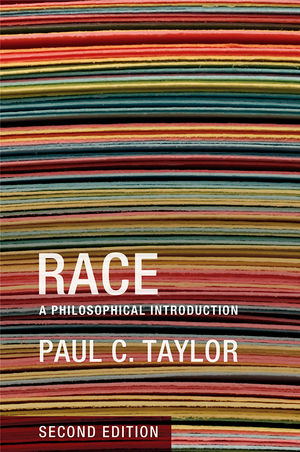 In Race: A Philosophical Introduction, Paul C. Taylor blends metaphysics and social philosophy, analytic philosophy and pragmatic philosophy of experience, to discuss relevant and important questions on what race means today: Don’t we know better than to talk about race now? Are there any races? What is it like to have a racial identity? The second edition’s new concluding chapter explores the racially fraught issues of policing, immigration, and global justice, and interrogates the thought that Barack Obama has ushered in a post–racial age. A rich and enjoyable read, finds Matt Hartman.
In Race: A Philosophical Introduction, Paul C. Taylor blends metaphysics and social philosophy, analytic philosophy and pragmatic philosophy of experience, to discuss relevant and important questions on what race means today: Don’t we know better than to talk about race now? Are there any races? What is it like to have a racial identity? The second edition’s new concluding chapter explores the racially fraught issues of policing, immigration, and global justice, and interrogates the thought that Barack Obama has ushered in a post–racial age. A rich and enjoyable read, finds Matt Hartman.
 Race: A Philosophical Introduction. Second Edition. Paul C. Taylor. Polity. April 2013.
Race: A Philosophical Introduction. Second Edition. Paul C. Taylor. Polity. April 2013.
It’s a particularly interesting time to (re)release a philosophical introduction to critical race theory, especially one that adopts an explicit focus on racial discourse in the contemporary United States. So far, 2013 has seen the Supreme Court strike down a key provision of the Voting Rights Act and impose strict scrutiny on the use of race policies in college admissions, while the NAACP began a series of weekly protests in North Carolina combating a new voter ID law and austere budget cuts with racial implications.
In this climate, a work such as the second edition of Paul C. Taylor’s Race: A Philosophical Introduction bears a great deal of weight. Taylor takes great care to direct his “little book” to the exigencies of American racial dynamics, attempting to correct the often muddled discourse surrounding such a divisive topic. His method includes frequent references to popular culture, historical developments, and ongoing policy discussions, showing Taylor’s audience here to be the general public: those who experience racial dynamics in the everyday―and who therefore most likely carry opinions, experiences, and entrenched attitudes into the debates―but who lack familiarity with the intellectual work surrounding the subject.
Taylor strains himself to bring as few assumptions as possible into the work, beginning at the very beginning by considering the question of what, if anything, we mean when we talk about race. He draws on ordinary language philosophy and pragmatism in order to examine common sense understandings of “race-thinking”, which he defines as “a way of assigning generic meaning to human bodies and bloodlines” (p. 16). Taylor colours this general notion with an intellectual history of the concept of race, tracing the shifts from ancient us/them dynamics to a pre-modern “theocentric ethnography”, to the modern form of race-thinking that defined the five commonly pictured Races (p. 23).
The need for historical details stems from two key ideas: first, the general anthropological fact that “the human population is made up of smaller groups…more like each other…than they are like members of other groups” (p. 21); and, second, that there is a “deeply contextual nature [to]…the practices of racial identification” (p. 8). A philosophy of race, then, is necessarily contextual to a certain culture. Specifically, it is tied to a distribution of “social goods” defined “along the lines laid down by the…systems of meaning” defined by racial discourse (p. 24). As such, Taylor claims, racial discourse is a phenomenon worth investigating even if race turns out to be a mere fiction.
Taylor spends such time clarifying “words” to pre-emptively guide a later focus on “things” when he turns to the metaphysics of race. He continues his intellectual history by claiming that it culminates today in “a post-modern racialism [that…] involves flattening difference, insisting on the unity of the human family and the declining significance of race” (p. 76). But this form still “allow[s] the existing patterns of privilege to remain more or less in place”, leaving deep socioeconomic inequities that Taylor highlights in terms of income difference, rates of interracial marriage, cultural standards of beauty, etc. (p. 77).
It is against this background of “‘post-racist’ racism” (p. 80) that Taylor delineates his theory of racial metaphysics. He refers to himself as a “radical constructionist,” claiming that races are real, though socially constructed, things. Like money, they were shaped by an accidental history and may not keep their meaning across cultural borders (Taylor explains that “a person might be white in São Paulo but black in San Francisco” (p. 8)). But, for Taylor, that only specifies what kinds of things races are―namely, things that are “ontologically subjective but epistemologically objective” (p. 93)―not that they aren’t real things. He concludes that “our social practices create populations as well as breeding groups, by connecting certain bodies and bloodlines to certain social locations and modes of treatment,” thus making races “probabilistically defined populations” whose members are likely to have similar experiences (p. 117).
But Taylor’s concern in Race is not just metaphysics. His work is self-consciously a work of activist philosophy that aims to engage with ongoing issues in society. To that end, much of the work tackles practical questions, including a chapter re-written for the second edition that considers whether America has become post-racial in the age of Obama. Taylor claims that the existence of post-racialism “can seem plausible only if issues like immigration can be rendered as non-racial phenomena” (p. 184). But Taylor argues that the very real questions of policy surrounding immigration debates give way to “a maelstrom of existential and cultural panic” that only exists because “immigrants…are imagined in racial terms” (p. 190). The factual record surrounding crime, economics, and security doesn’t justify the intense worries that have historically latched on to the immigrant question, leading Taylor to conclude that “insisting on the salience of race to these phenomena will reveal things about them, and connections between them, that we might otherwise miss” (p. 202).
That modest conclusion defines Race as a whole. Taylor is nobly aware of the state of his topic today, and he deftly utilizes that knowledge to introduce readers to the long history of philosophical work surrounding race by carefully connecting the philosophical issues to students of anthropology, sociology, and political science. Taylor does admirably in that task, clarifying typical assumptions and ensuring the purchase of his work on ordinary life. But it also means he amplifies the inherent difficulty of balancing depth and breadth as he tries to juggle disciplines along with varying schools of thought (notably giving Foucault short shrift). Most disappointing is Taylor’s decision to open each chapter with short bits of dialogue he penned himself when he’d have been better served providing a literary reading. This is especially noticeable given the fact that he mentions Shakira, Chris Rock, and even Sir Mix-a-lot at various points.
But these small faults aside, Taylor has succeeded at introducing a wide audience to a timely and rich topic with considerable purchase on the American social discourse he targets.
——————————————————-
Matt Hartman is a writer and critic whose work has appeared in Forge, Colloquium, ASAGE, and The New Internationalist. He studied philosophy and the humanities at the University of North Carolina at Chapel Hill and the University of Chicago where he focused on the nature of the self. He currently lives in Durham, North Carolina. Read more reviews by Matt.








1 Comments